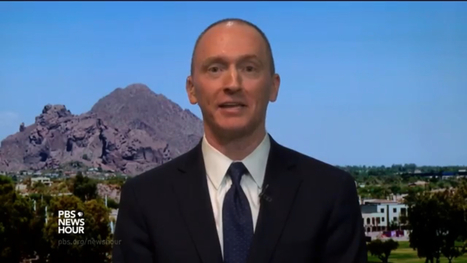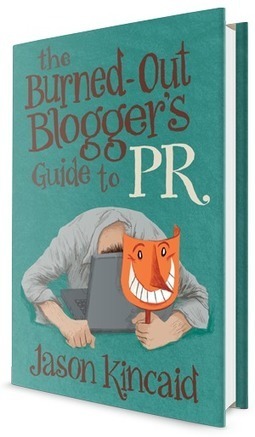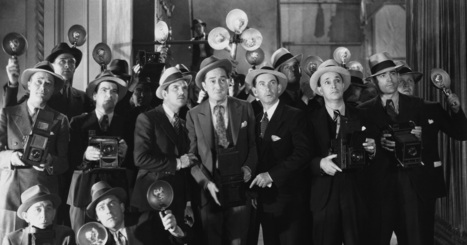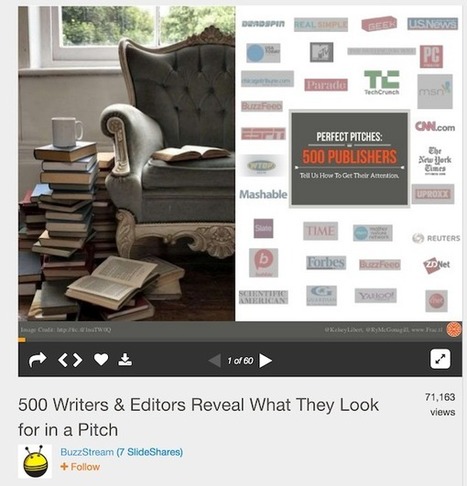 Your new post is loading...
 Your new post is loading...
This week, enigmatic former Donald Trump campaign advisor Carter Page appeared on a PBS News Hour interview to defend himself from the revelation that he was caught on a phone wiretap colluding with Russian intel agents during the election. This came as a surprise because Page’s last publicly known location was Moscow, suggesting he had already fled the country. He told PBS this week he’s Arizona – but he was standing in front of what appears to be a fake background that has been used before by other political figures.Here’s a screen grab of Carter Page’s interview on PBS News Hour this week. If your first thought was “Why is he standing outdoors in front of a mountain during a remote television interview,” we asked the same question. And if your second thought was “Does he look like he’s poorly superimposed on that fake looking background,” we asked that question as well. So we went digging, using a Google image reverse-search, and we uncovered this strangely familiar image of Arizona Congressman Trent Franks giving an MSNBC interview in 2016 in front of the exact same scene:...
The prevailing wisdom in PR has been that you should keep hammering away at the key messages you're trying to get across in a media interview, no matter what.Is the reporter asking you a completely unrelated question? Doesn't matter—repeat your key message. Do they want to speak to you about an issue or topic your key messages don't even cover? Doesn't matter—repeat your key message.Is the interview a fairly relaxed conversation about your company's strategy, rather than a reputation-destroying crisis? One size fits all—just repeat your key message.If you do this enough, this line of PR thinking goes, your points will stick and the reporter will repeat them. The industry even gave this approach a name of its very own: "block (the reporter's actual question) and bridge (to your key message)." Great—except it rarely works....
Yesterday, Tribune Publishing, purveyor of news since 1847, changed its name to “tronc” (short for “Tribune Online Content.”) It’s now a “content curation and monetization company” — a company that makes money from content, what we used to call a media company. Today, I deconstruct the rest of its attempt to use techno-drivel to misdirect our attention from its problems. Crisis-tossed Tribune Publishing, which owns the Chicago Tribune, the LA Times, and dozens of other papers, has suffered through a sale to a billionaire, a bankruptcy, a corporate split, newsroom turmoil, massive layoffs, and an unsolicited takeover offer. Now, as “tronc,” the company wants to be considered alongside Silicon Valley startups. (If this trend catches on, will the Boston Globe company become “hubstuff” and the New York Times “gray_lady”?) The tronc press release is a classic, because it reveals that when a media company wants to reinvent itself as a technology company, it drapes its press release in the same techno-drivel that tech companies use. Instead of meaningless media and corporate bullshit, we get meaningless, shiny Silicon Valley bullshit. It’s a transformation (you can tell because the release mentions “transform” or “transformation” six times).In the commentary below, I’ve added bold to indicate passives, meaningless superlatives, and especially, new-age jargon. I add commentary in brackets and commonsense translations below each section....
The Republican frontrunner met with the editorial board on Monday morning. The full transcript follows at the link above: FREDERICK RYAN JR., WASHINGTON POST PUBLISHER: Mr. Trump, welcome to the Washington Post. Thank you for making time to meet with our editorial board. DONALD TRUMP: New building. Yes this is very nice. Good luck with it. RYAN: Thank you… We’ve heard you’re going to be announcing your foreign policy team shortly… Any you can share with us? TRUMP: Well, I hadn’t thought of doing it, but if you want I can give you some of the names… Walid Phares, who you probably know, PhD, adviser to the House of Representatives caucus, and counter-terrorism expert; Carter Page, PhD; George Papadopoulos, he’s an energy and oil consultant, excellent guy; the Honorable Joe Schmitz, [former] inspector general at the Department of Defense; [retired] Lt. Gen. Keith Kellogg; and I have quite a few more. But that’s a group of some of the people that we are dealing with. We have many other people in different aspects of what we do, but that’s a representative group....
Since its launch in 2011, the Taste blog has become a crucial piece of the marketing efforts at General Mills—from helping the company break big news to highlighting its emphasis on corporate sustainability.
“We wanted to use the blog to tell the stories we wanted to tell—the ones the media wasn’t picking up on or that we wanted to give some attention to,” said Kevin Hunt, who founded the blog and acts as GM’s corporate social media manager.
“Our team looked at it as a way to keep consumers and journalists up to speed on what’s going on across General Mills. In many instances, Taste gives journalists a reason to pick up the phone and call us.”
In the case of the new HefeWheaties beer, Hunt published an articleon the blog about the product on August 12. Within a day, it had already led to placements in national media outlets like NPR,Fortune, and NBC News....
Though there are many things to consider when designing an image for a campaign, one crucial thing often falls by the wayside: optimizing the image for the width of the site you're pitching. Editors don't want to make their readers have to struggle to understand your image, so if your design is too wide or narrow for the site you're pitching, you could easily be rejected.
With that in mind, Fractl and BuzzStream looked at the main or featured body tag images for 35 of the top publishers to determine the most popular widths. We also looked at any larger layouts and pop-ups to determine a maximum width for each publisher when available.
We’ll walk you through four insights below that will help eliminate some of the guesswork during your next design phase....
When my boss sent an email saying we should buy former TechCrunch reporter Jason Kincaid’s book, The Burned-Out Blogger’s Guide to PR, she included a link to a review of the book and noted that it explained a lot of our challenges. I admit I was hooked by the first paragraph of the article:“Then-TechCrunch writer Jason Kincaid was attending a press event in San Francisco, frantically trying to finish his story before the embargo lifted. When someone from the company came over to ask how things were going, he blurted out: ‘I hate you.’
”As a former reporter myself (though more on the lighthearted side), I knew I would likely relate to some of his peeves. However, spending some time on the “dark side” has been a bit of a humbling experience. Kincaid reminds us a few times that reporters are people, but I’d like to remind everyone that PR reps are people, too.
Regardless, in between the slightly bitter generalizations and laugh-out-loud moments in this book, there’s a lot of great information and important reminders for startups as well as every PR professional. Here are a few of my favorites:...
Marketers and journalists have a long and not-always happy history. A marketer is always trying to make his or her story interesting and compelling enough to spark the interest of a journalist. The journalist, on the other hand, is always trying to separate the wheat from the chaff; only writing stories that have some intrinsic value, bring page views, or some other form of audience reaction. Journalists view it as an unfortunate part of their jobs that they must constantly poke holes in marketing or PR pitches in order to avoid unwanted puff pieces for individuals, products, or organizations.
This tension between the two sides has led to an energetic, and some would say outrageous, relationship between marketing and journalism. Still, marketers and PR folks know they must develop their relationships with journalists on a fairly constant basis in order to be successful at their work. If you are an online marketer who usually has the cyber door slammed in your face by journalists, here are a few things to consider:...
|
Journalists are busy people. If you bring something to their attention that captures their imagination—or, more importantly, the imagination of their readers, listeners and/or viewers—it has a chance of being newsworthy. Newsworthiness is critical to gaining and keeping access to journalists. If you contact them with information of marginal value that wastes their time, barriers grow. And, each time you waste their time, access becomes harder the next time around. So, when deciding whether or not to contact the media about a story (or asking your public or media relations professionals to do so), the most important thing to ask yourself is: Is this newsworthy?...
Apparently, there are 4.6 of you for every one of me, and yet most of the time, I can’t get a call back from a communications person to save my life.
I am a newspaper reporter who covers county government, but my paper is fairly loose with beat restrictions, so I also write about a lot of random things that interest me (recent examples: the plight of the public-health dentist, employee retention rates in law enforcement).
Writing outside of my beat requires that I spend a healthy chunk of my daily reporting life reaching out to PR pros, the vast – vast – majority of whom refuse to communicate with me.
It happens often enough that I cringe when I have to contact a rep I don’t know, because it almost always results in me sitting at my desk moaning, “But I’m a nice person!” while staring at the phone and hitting refresh on my inbox. (You may notice those two stories above do not quote a representative from a state or national agency. This is not for lack of trying.)...
Journalists often speak of their interest in covering trends, and tying your clients to larger issues in the news can be a fruitful tactic. This was probably the thinking when I received a press release about a Pennsylvania hospital’s efforts to “go green.” Normally, it would have gone straight to the delete bin, but since I’m originally from the Keystone State and have some interest in green business practices, I gave the email an extra look. It turned out to be from a company that had just signed a contract to supply the facility with biodegradable trash bags. Now, I’m all for using eco-friendly materials, but the press release made it sound as if the place had just built a new emergency room from recycled bean sprouts: “We’re delighted that such a prominent institution recognizes the contribution [our product] can make to reduce the environmental impact of its daily operations. Our commercial product can be tailored for all kinds of applications and offers an important way for health care facilities, which by necessity generate large amounts of waste, to do the right thing for our environment.” Fast forward. An email arrived from a PR firm in Arizona promising an expert who could discuss hospitals’ efforts to improve “the patient experience.” The expert, I learned, is the CEO of a company that makes patient gowns. Let’s set aside the fact that both emails were woefully off-target (I’m actually sort of grateful, because they provided nice material for a column). What they have in common is that many folks would charitably call them a “stretch.” Both cited legitimate trends, but each was missing a key ingredient: A newsworthy (or quote-worthy) client....
Media relatiions alonr doesn’t drive a PR strategy for a brand or client, but that doesn’t mean outreach to journalists is dead—nor even dying a slow death.
Citing a decline in print media, an increase in brand and news media partnerships and a rise in content marketing, some experts say that PR pros rely too heavily on building rapport with reporters.
I disagree with this conclusion.To the contrary, those points reinforce the necessity for the practice. Here’s why:...
Even the most experienced of us, can still learn a thing or two about pitching the press more effectively. I myself find that in the art of pitching, there’s definitely a continuous process of learning to refine the pitch and deliver the message in the best way possible.
With that thought in mind, as a side project, my colleagues and I have created a site entitled, “How To Pitch Me” that aims to help those who strive to pitch reporters in today’s tech landscape. Every week, we upload a Q&A submission by a different writer that will help folks understand how to become more skilful in pitching.
While reading these various submissions, I have noticed that there are certain tips that repeatedly come up. These pointers have also been shared with me by many writers in the past nine years that I have been doing public relations work. I decided to compile all these insights into one post that will be truly valuable for The Next Web’s community looking to gain insight on how to pitch right. Here are the top ten pointers:...
But making contact with someone is just the first step. You can’t go a year between emails with someone and still expect them to care about your clients. You need to keep in touch.
Unfortunately, we have a double edged sword here. The larger your network of contacts is, the more of an asset you are. But on the other hand, the larger your network is, the harder it is to stay in touch with everyone.
Fortunately, we live in the world where there’s an app for everything. Sign up for these networking tools to build a stronger professional network for your PR agency...
PR leaders have to wade through lots of noise.
Some reporters, for instance, are difficult to reach due to the hundreds of pitches that they’re receiving per day via e-mail and Help a Reporter Out (HARO). What PR leaders need are techniques to stand out and outsmart the accidental mess created by the industry.
This process involves learning and experimentation with new communication, content marketing, and information management tools—more importantly, it involves a paradigm shift in how the PR industry builds connections with the media world.
The time to explore and try new techniques has never been better. Here are 7 resources to help you make the most out of your next brain break....
|



 Your new post is loading...
Your new post is loading...






















Very, very fake campaign spokesman. Funny story!